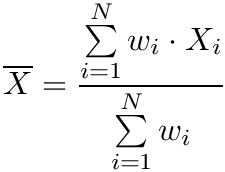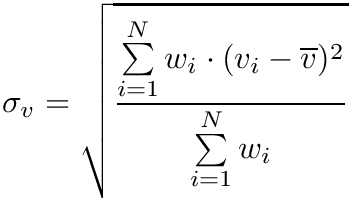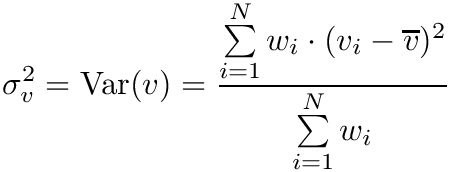 |
JKQTPlotter trunk/v5.0.0
an extensive Qt5+Qt6 Plotter framework (including a feature-richt plotter widget, a speed-optimized, but limited variant and a LaTeX equation renderer!), written fully in C/C++ and without external dependencies
|
 |
JKQTPlotter trunk/v5.0.0
an extensive Qt5+Qt6 Plotter framework (including a feature-richt plotter widget, a speed-optimized, but limited variant and a LaTeX equation renderer!), written fully in C/C++ and without external dependencies
|
Typedefs | |
| typedef std::function< double(double)> | JKQTPStatGroupDefinitionFunctor1D |
| a functor | |
Functions | |
| template<class InputCatIt, class InputValueIt, class OutputGroupIt> | |
| void | jkqtpstatGroupData (InputCatIt inFirstCat, InputCatIt inLastCat, InputValueIt inFirstValue, InputValueIt inLastValue, OutputGroupIt outFirstCategory, std::map< double, std::pair< std::vector< double >, std::vector< double > > > &groupeddata, JKQTPStatGroupDefinitionFunctor1D groupDefFunc=&jkqtpstatGroupingIdentity1D) |
| groups data from an input range inFirstCat / inFirstValue ... inLastCat / outFirstCat representing pairs | |
| template<class InputCatIt, class InputValueIt, class OutputGroupIt> | |
| void | jkqtpstatGroupData (InputCatIt inFirstCat, InputCatIt inLastCat, InputValueIt inFirstValue, InputValueIt inLastValue, OutputGroupIt outFirstCategory, std::map< double, std::vector< double > > &groupeddata, JKQTPStatGroupDefinitionFunctor1D groupDefFunc=&jkqtpstatGroupingIdentity1D) |
| groups data from an input range inFirstCat / inFirstValue ... inLastCat / outFirstCat representing pairs | |
| template<class InputCatIt, class InputValueIt> | |
| void | jkqtpstatGroupData (InputCatIt inFirstCat, InputCatIt inLastCat, InputValueIt inFirstValue, InputValueIt inLastValue, std::map< double, std::pair< std::vector< double >, std::vector< double > > > &groupeddata, JKQTPStatGroupDefinitionFunctor1D groupDefFunc=&jkqtpstatGroupingIdentity1D) |
| groups data from an input range inFirstCat / inFirstValue ... inLastCat / outFirstCat representing pairs | |
| template<class InputCatIt, class InputValueIt> | |
| void | jkqtpstatGroupData (InputCatIt inFirstCat, InputCatIt inLastCat, InputValueIt inFirstValue, InputValueIt inLastValue, std::map< double, std::vector< double > > &groupeddata, JKQTPStatGroupDefinitionFunctor1D groupDefFunc=&jkqtpstatGroupingIdentity1D) |
| groups data from an input range inFirstCat / inFirstValue ... inLastCat / outFirstCat representing pairs | |
| jkqtmath_LIB_EXPORT double | jkqtpstatGroupingCustomRound1D (double v, double firstGroupCenter, double groupWidth) |
| assign each value to groups | |
| jkqtmath_LIB_EXPORT double | jkqtpstatGroupingIdentity1D (double v) |
| use a column value as group ID directly | |
| jkqtmath_LIB_EXPORT double | jkqtpstatGroupingRound1D (double v) |
| use a rounded column value as group ID directly | |
| jkqtmath_LIB_EXPORT JKQTPStatGroupDefinitionFunctor1D | jkqtpstatMakeGroupingCustomRound1D (double firstGroupCenter, double groupWidth) |
| generates a functor of jkqtpstatGroupingCustomRound1D() with the two paramaters firstGroupCenter and groupWidth fixed to the given values | |
| typedef std::function<double(double)> JKQTPStatGroupDefinitionFunctor1D |
a functor 


The simplest version are e.g.
|
inline |
groups data from an input range inFirstCat / inFirstValue ... inLastCat / outFirstCat representing pairs 






| InputCatIt | standard iterator type of inFirstCat and inLastCat |
| InputValueIt | standard iterator type of inFirstValue and inLastValue |
| OutputGroupIt | standard output iterator type of outFirstCategory |
| inFirstCat | iterator pointing to the first item in the category dataset to use | |
| inLastCat | iterator pointing behind the last item in the category dataset to use | |
| inFirstValue | iterator pointing to the first item in the category dataset to use | |
| inLastValue | iterator pointing behind the last item in the category dataset to use | |
| [out] | outFirstCategory | for each element in the range inFirstCat / inFirstValue ... inLastCat / outFirstCat this receives the calculated category |
| [out] | groupeddata | receives the grouped data, each key in the map represents one group, each map-value contains two vecors with the category and value data respectively |
| groupDefFunc | assigns a group |
|
inline |
groups data from an input range inFirstCat / inFirstValue ... inLastCat / outFirstCat representing pairs 






| InputCatIt | standard iterator type of inFirstCat and inLastCat |
| InputValueIt | standard iterator type of inFirstValue and inLastValue |
| OutputGroupIt | standard output iterator type of outFirstCategory |
| inFirstCat | iterator pointing to the first item in the category dataset to use | |
| inLastCat | iterator pointing behind the last item in the category dataset to use | |
| inFirstValue | iterator pointing to the first item in the category dataset to use | |
| inLastValue | iterator pointing behind the last item in the category dataset to use | |
| [out] | outFirstCategory | for each element in the range inFirstCat / inFirstValue ... inLastCat / outFirstCat this receives the calculated category |
| [out] | groupeddata | receives the grouped data, each key in the map represents one group, each map-value contains a vector with the value data |
| groupDefFunc | assigns a group |
|
inline |
groups data from an input range inFirstCat / inFirstValue ... inLastCat / outFirstCat representing pairs 






| InputCatIt | standard iterator type of inFirstCat and inLastCat |
| InputValueIt | standard iterator type of inFirstValue and inLastValue |
| inFirstCat | iterator pointing to the first item in the category dataset to use | |
| inLastCat | iterator pointing behind the last item in the category dataset to use | |
| inFirstValue | iterator pointing to the first item in the category dataset to use | |
| inLastValue | iterator pointing behind the last item in the category dataset to use | |
| [out] | groupeddata | receives the grouped data, each key in the map represents one group, each map-value contains two vecors with the category and value data respectively |
| groupDefFunc | assigns a group |
|
inline |
groups data from an input range inFirstCat / inFirstValue ... inLastCat / outFirstCat representing pairs 






| InputCatIt | standard iterator type of inFirstCat and inLastCat |
| InputValueIt | standard iterator type of inFirstValue and inLastValue |
| inFirstCat | iterator pointing to the first item in the category dataset to use | |
| inLastCat | iterator pointing behind the last item in the category dataset to use | |
| inFirstValue | iterator pointing to the first item in the category dataset to use | |
| inLastValue | iterator pointing behind the last item in the category dataset to use | |
| [out] | groupeddata | receives the grouped data, each key in the map represents one group, each map-value contains a vector with the value data |
| groupDefFunc | assigns a group |
| jkqtmath_LIB_EXPORT double jkqtpstatGroupingCustomRound1D | ( | double | v, |
| double | firstGroupCenter, | ||
| double | groupWidth ) |
assign each value to groups 



This is equivalent to 
| jkqtmath_LIB_EXPORT double jkqtpstatGroupingIdentity1D | ( | double | v | ) |
use a column value as group ID directly
| jkqtmath_LIB_EXPORT double jkqtpstatGroupingRound1D | ( | double | v | ) |
use a rounded column value as group ID directly 
| jkqtmath_LIB_EXPORT JKQTPStatGroupDefinitionFunctor1D jkqtpstatMakeGroupingCustomRound1D | ( | double | firstGroupCenter, |
| double | groupWidth ) |
generates a functor of jkqtpstatGroupingCustomRound1D() with the two paramaters firstGroupCenter and groupWidth fixed to the given values
This is equivalent to std::bind(&jkqtpstatGroupingCustomRound1D,std::placeholders::_1,firstGroupCenter,groupWidth);